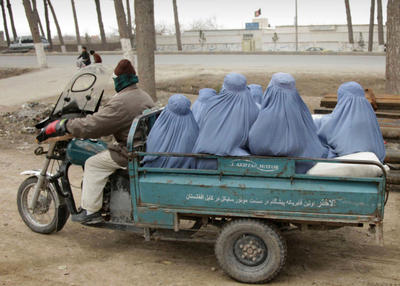As 2011 drew to a close, experts inside and outside the region predicted threats to regime security associated with the spread of the Arab Spring, the rise of Islamic radicalism and leadership change — particularly in Kazakhstan and Uzbekistan where the incumbent presidents are well into their seventies. None of these fears materialised.
There were no anti-government protests under the slogans of democracy, and local populations remained indifferent to the political turmoil in the Arab world. In Kazakhstan, the party of the President Nursultan Nazarbayev won 81 per cent of the votes in parliamentary elections, reducing the two other parties in the national legislature’s lower house to a largely symbolic role. Presidential elections in Turkmenistan also produced no surprises. The incumbent head of state, Gurbanguly Berdymuhammedov, garnered 97 per cent of the votes in an electoral farce. Berdymuhammedov’s cult of personality is gathering momentum: he has adopted the title of Arkadag, or Protector, attained the military rank of Marshal, and proclaimed the ‘Era of Great Renaissance’ under his tutelage.
Kyrgyzstan’s President Almazbek Atambaev, elected in October 2011, consolidated his rule against clan-based opposition from the south and west of the country. The opposition’s half-hearted attempt to capture government buildings in the capital in October 2012 was neutralised, and municipal elections in November showed popular support for Atambaev and his party at the grassroots level.
Legislative and police crackdowns on Islamic radicalism were a common feature of domestic politics in all Central Asian countries in 2012. There are jihadi groups in the region, but religious extremism holds little public appeal in Central Asia, especially compared to Afghanistan and Pakistan.
This didn’t stop local regimes from tightening the screws on religion. All religious organisations in Kazakhstan were forced to re-register in 2012. Around one-third of them failed to do so — most of these were mosques and Islamic communities and charities that did not show sufficient deference to government guidance and regulation. In January 2012, the government of Tajikistan closed down 270 places of Muslim worship on the grounds of ‘illegal performance of religious rites’, and Tajik President Emomali Rahmon enforced a ban on sermons in mosques on topics that were not pre-approved by the government. At the same time, he directed public funds toward official Islamic establishments and took pride in being put on a Jordanian think tank’s list of Top 500 Most Influential Muslims in the World.
Rahmon needs votes from pious Muslims as he faces an election in 2013, where he will be challenged by the Islamic Renaissance Party of Tajikistan (IRPT), a moderate Islamic party. Meanwhile, the regime has been trying to link the IRPT to proscribed radical groups such as the Islamic Movement of Uzbekistan and Hizb ut-Tahrir.
The greatest challenge to the regime lies in sub-ethnic regionalism, which caused a civil war in 1992–97 and reared its head again in July 2012 when a government general was killed in the eastern region of Badakhshan. The ensuing conflict resulted in 42 casualties, according to official sources, and was defused with great difficulty.
The region is in a state of strategic uncertainty as NATO prepares to withdraw from Afghanistan in 2014. All Central Asian regimes are pessimistic about the future of their southern neighbour and are increasingly making a choice between the United States and Russia. On the one hand, Kazakhstan, Kyrgyzstan and Tajikistan moved closer to Moscow within the framework of the Collective Security Treaty Organisation (CSTO) and through bilateral deals. Tajikistan agreed to house a major Russian military base on its territory until 2042, and Moscow promised military and security aid to Kyrgyzstan and Tajikistan to the tune of US$1.5 billion over the next five years.
On the other hand, Uzbekistan left the CSTO in June 2012 following Tashkent’s rapprochement with Washington. The US stopped criticising President Islam Karimov’s horrific human rights record because of their need to supply troops in Afghanistan using the Northern Distribution Network and ensure their safe withdrawal via Uzbekistan. Karimov hopes to inherit NATO’s heavy weapons and war materiel that would no longer be required in Afghanistan. Turkmenistan, its official neutral status notwithstanding, also gravitated closer to the US in 2012, receiving US$820 million of Pentagon money.
In 2013, Tajikistan will be the country to watch for further signs of domestic instability. An economic downturn may destroy the precarious balance of power between clans in Kyrgyzstan. Other Central Asian republics appear stable. Islam Karimov does not even have to face elections in Uzbekistan until 2015. However, a premature departure of the Uzbek leader, who will turn 75 in January 2013, might lead to a succession crisis in a country with weak institutions. The same logic applies to Kazakhstan.
On a regional level, Uzbekistan, bolstered by US support, may become more aggressive toward its Central Asian neighbours. Disputes over borders, water and other resources, which result in periodic standoffs with Tajikistan in particular, may gain in frequency and intensity. Internationally, the Central Asian republics will continue to prepare for the challenge of post-NATO Afghanistan, cementing current alliances and perhaps trying new security arrangements featuring Iran, China and other international actors.
Dr Kirill Nourzhanov is Deputy Director at the Centre for Arab and Islamic Studies, the Australian National University.
This is part of a special feature on 2012 in review and the year ahead.

